- STARGAZING IN PHOENIX – 27 EPIC SPOTS FOR DARK SKIES - November 25, 2024
- STARGAZING IN SEDONA – 23 EPIC SPOTS FOR DARK SKIES - November 24, 2024
- STARGAZING IN FLAGSTAFF – 13 EPIC SPOTS TO GO - November 20, 2024
Looking for places to enjoy stargazing in Phoenix? Read further to find out all about Phoenix’s top stargazing locations.
Despite being a huge city, a few minutes away from the city offers you incredible spots in Phoenix for stargazing, whether on easy trails or driving around parks to remote dark sky parks.
This guide covers all about stargazing in Phoenix, including what to expect, where to find the best spots, and other things to know to plan your trip.
WHEN IS THE BEST TIME FOR STARGAZING IN PHOENIX?
Arizona is a year-round destination for stargazing, with at least 200 days of clear skies throughout the year.
Arizona’s monsoon season between July and September is the only exception.
The months between October and June are great for stargazing in Phoenix.
The best time of year to stargaze in Phoenix is the cooler months, from late fall to early spring.
The skies are clearer, and the humidity levels are very low, which enhances visibility, opening up stunning night sky for admirers.
If you want to specifically see the Milky Way while visiting Phoenix, I recommend planning a stargazing trip to Sedona as the skies are the best there.
LOOKOUT MOUNTAIN
Lookout Mountain Preserve, a municipal park in the northern part of Phoenix, is one of the best places to enjoy stargazing in Phoenix.
Lookout Mountain is one of the best spots to watch sunset near Scottsdale and Phoenix.
You can enjoy the best views on its mile out-and-back trail.
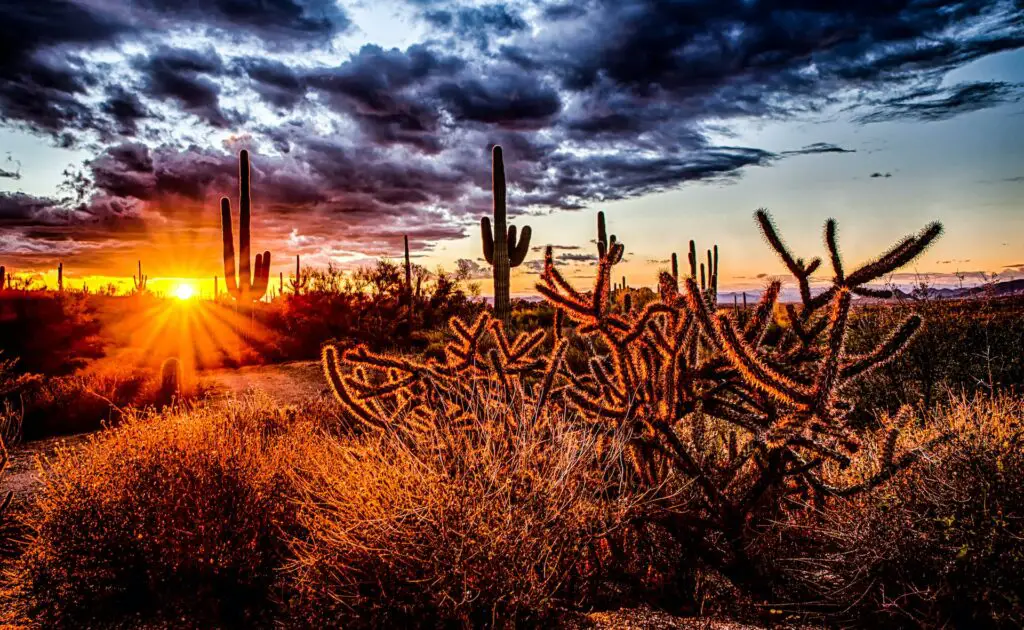
The trail is open until 11 PM, so a night hike offers a stunning panorama of the sky paired with the city below.
Remember to carry a torch and cozy blankets and wear sturdy shoes as some spots are difficult.
You can even bring your dogs on a leash.
At the end of the climb, you will be rewarded with glorious views of the setting sun against the desert vegetation carpeted mountains, the skyline of Scottsdale and Phoenix valley.
ARIZONA SCIENCE CENTER
Located in the heart of downtown Phoenix, Arizona Science Center is one of the top stargazing spots in Az thanks to its convenient location and many splendid opportunities.
It is one of the best places to enjoy stargazing in Arizona with kids as it offers many interactive experiences like the American Airlines Flight Zone exhibit, permanent exhibitions, and amazing shows in the Dorrance Planetarium and its IMAX Theater.
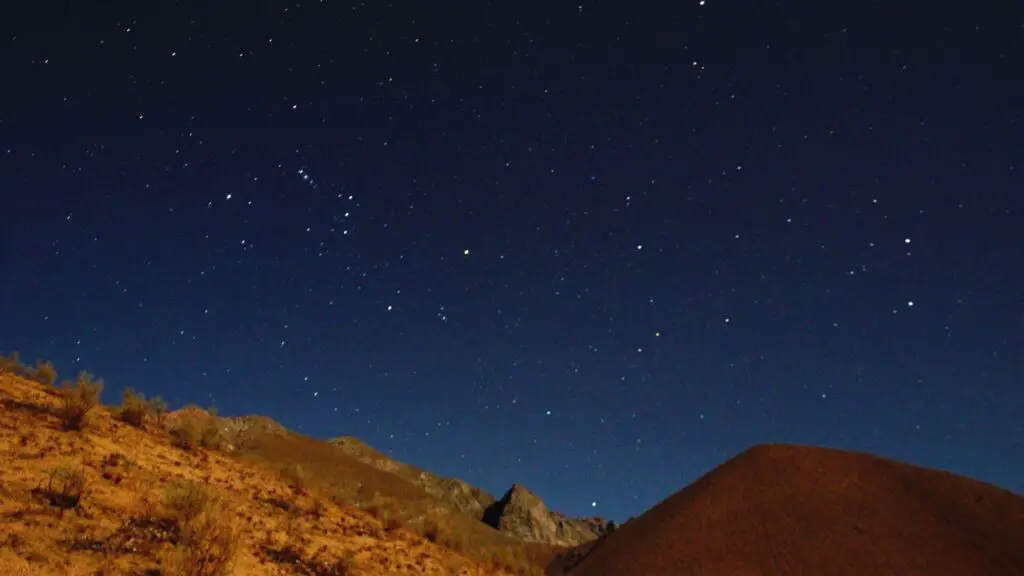
One of the top notch experiences is the tour of the solar system here at the world’s first NanoSeam dome.
Check their website for updated tours and programs
Opening hours – 10 AM to 5 PM
DESERT BOTANICAL GARDEN
One of the most accessible locations to enjoy Scottsdale sunset is the Desert Botanical Garden, located 15 minutes from downtown Phoenix.
Home to thousands of varieties of desert plants native to the American Southwest, it is also one of the top Phoenix sunrise spots to enjoy stunning views of colorful skies against the garden’s saguaros, chollas, and cacti.
It is also one of the best places to watch a sunset in Phoenix.
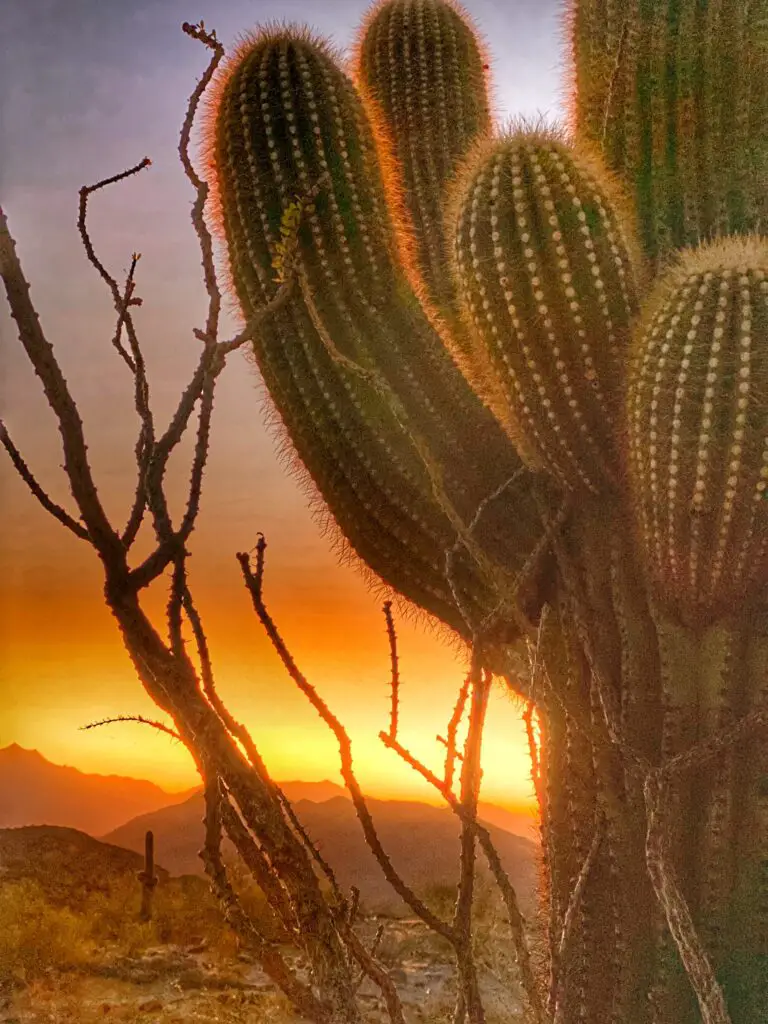
There are five trails based on different themes that will offer glimpses of the people of the Sonoran Desert, along with introducing you to a plethora of beautiful desert wildflowers.
Conveniently located in Phoenix, Desert Botanical Garden offers a perfect spot to enjoy the Milky way, despite being close to the urban area.
There are many stargazing events held here regularly where telescopes are also provided.
Check their website here for programs and events here. It is an amazing stop for an easy star gazing trip.
SAN TAN MOUNTAIN REGIONAL PARK
Consisting of over 10,000 acres of trails, San Tan Mountain Regional Park is one of the most adventurous places for stargazing in Phoenix.
A popular spot for mountain biking, the park offers an evening mountain biking program, Night Shredders, which is a fun way to spend a night under the dark skies.
TEMPE TOWN LAKE
One of the unique ways of experiencing stargazing in Phoenix is at Tempe Town Lake.
Sign up for the epic glow-in-the-dark paddling at the lake.
Each kayaker is provided with glow-in-the-dark equipment.
With your kids, you can go around the lake at night and admire the stars as you paddle. It’s a fun night, for sure.
One of the best lakes in Arizona, Tempe Town is one of the top things to do in Tempe AZ. So you have plenty to do on a picnic at the lake.
Tempe Town Lake is a popular local spot for walking, jogging, and biking, and one of the largest urban lakes spanning 224 acres.
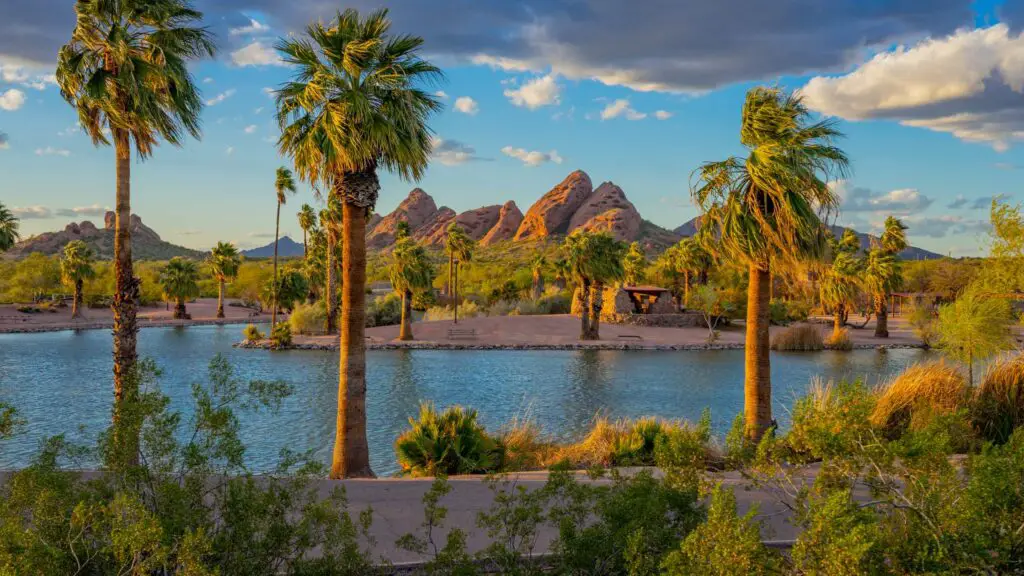
Head to the northern end of the lake, which has boat ramps and spaces for fishing, playing, and sunbathing.
There is a marina with boat rentals, picnic ramadas, multi-use trails, a playground and splash pads.
You can fish Walleye, largemouth bass, yellow bass, rainbow trout, bluegill, channel catfish and crappie regularly stocked.
RIPARIAN PRESERVE AT WATER RANCH
Riparian Preserve at Water Ranch is in Gilbert, established to conserve wildlife that you can spot spread over 4.5 miles of trails.
Home to the Gilbert Rotary Centennial Observatory, the Riparian Preserve at Water Ranch is one of the underrated places in Phoenix to watch dark skies.
Check out the stunning night skies through a 16-inch-diameter Meade and a modified Richey-Cretien scope.
The observatory is open to visitors every Friday and Saturday evening at nightfall, making it ideal for stargazing on the weekend.
Check their website here for updates on their events and programs.
SONORAN DESERT PRESERVE(APACHE WASH TRAIL)
If you are looking for offbeat sunset hikes in Phoenix, one of the best-secluded places to watch a sunset in Phoenix is near the Sonoran Desert Preserve on the Apache Wash trail hike.
You will cross bridges across the washes and pass through beautiful desert scapes before arriving at the vantage points to enjoy the sunset spectacle.
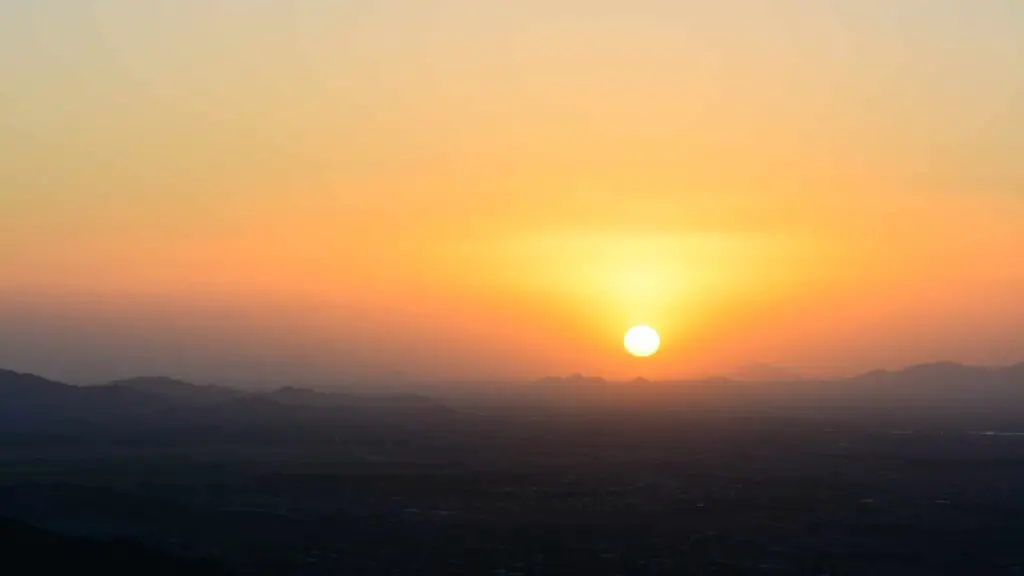
There is a large parking lot near the trailhead. On your sunset hike near Phoenix, you will find runners and hikers(mostly locals).
Two out-and-back options are available: a shorter, roughly 2-mile loop with moderate elevation change and a longer 5-mile loop with more significant elevation.
Both will pass through the wash before opening up to many viewpoints. Both trails offer splendid views.
You can enjoy birdwatching and have an early picnic.
The open platforms at the end of trails offer a stunning wide panorama of the dark desert and starry skies above, making it one of the noteworthy places to enjoy stargazing in Phoenix.
MORE PLACES FOR STARGAZING IN PHOENIX(more than 30 Minutes away)
WHITE TANK MOUNTAIN REGIONAL PARK
One of the largest parks in Arizona, White Tank Mountain Regional Park, located in west-central Maricopa County offers one of the best sunsets in Phoenix if you are up for a short drive out of the city and a hike.
Spread across 30,000 acres featuring miles and miles of untouched Sonoran desert wilderness, the park is a popular spot for hiking, mountain biking, camping and picnics.
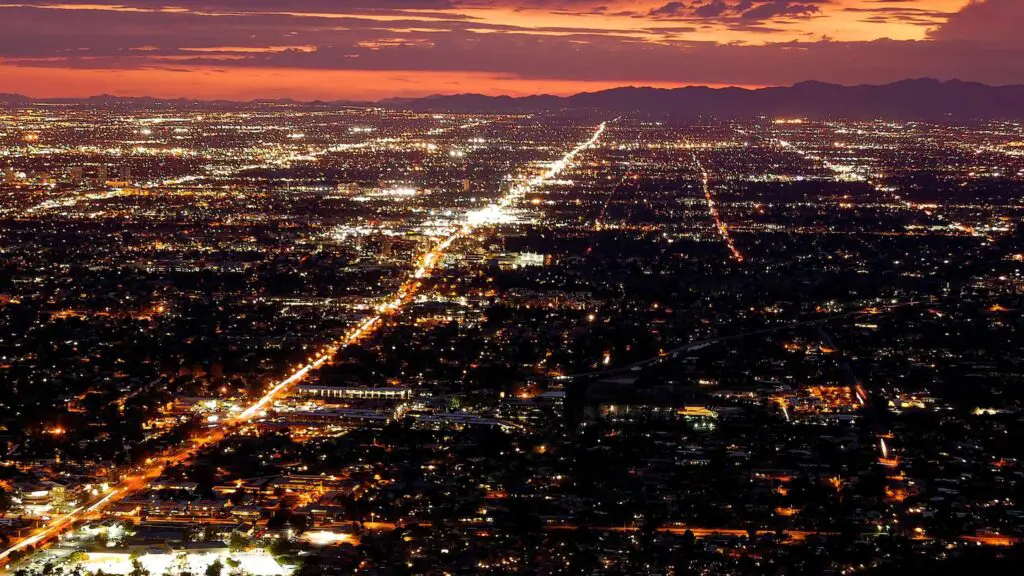
Also, check out the hundreds-of-years-old petroglyphs belonging to Native Americans, the earliest inhabitants in the region.
Along with being one of the best places to go stargazing near Phoenix, White Tank Mountain Regional Park also offers Stargazing for Everyone events.
I highly recommend joining this event while planning a trip for an epic stargazing experience in Phoenix.
USERY MOUNTAIN REGIONAL PARK
One of the top Arizona winter hikes for an epic sunrise in Scottsdale is Usery Mountain Regional Park, located about 25 minutes from downtown.
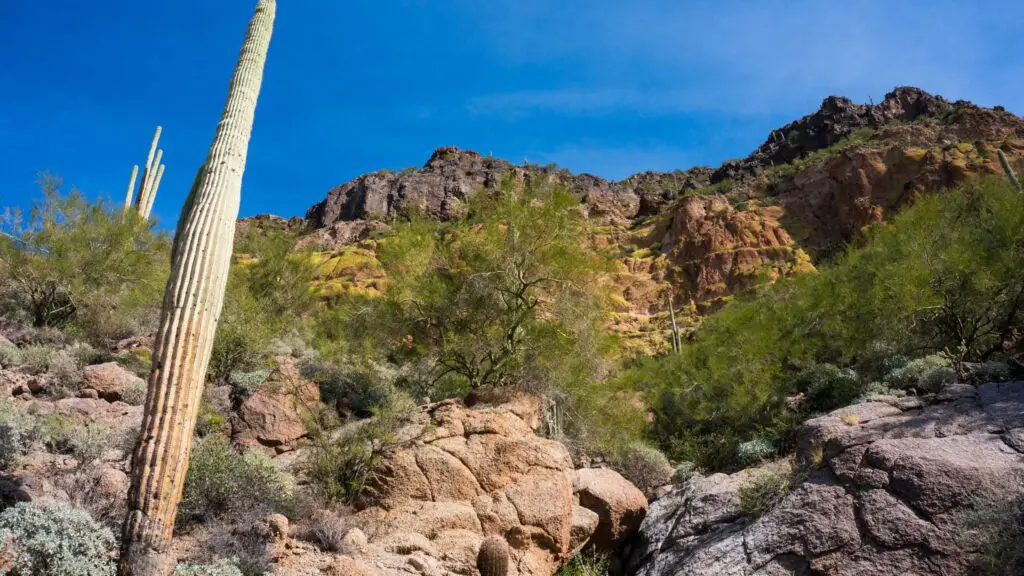
Home to over 30 trails of varying lengths and difficulties to explore, Usery Mountain Regional Park has many routes that you can explore.
Some of the popular trails for sunrise hikes at Usery Mountain Regional Park include Merkle Trail (Easy) and Wind Cave Trail (Medium).
Since Usery Mountain Regional Park is secluded from any potential light pollution, it is one of the top stargazing spots in Phoenix.
CATALINA STATE PARK
Known for stunning views of grey-tinged granite peaks of the Santa Catalina Mountains and thousands of Saguaro cacti forming splendid silhouettes, Catalina State Park is one of the best Tucson sunset spots.
The state park is a popular spot for camping, hiking, and bird watching.
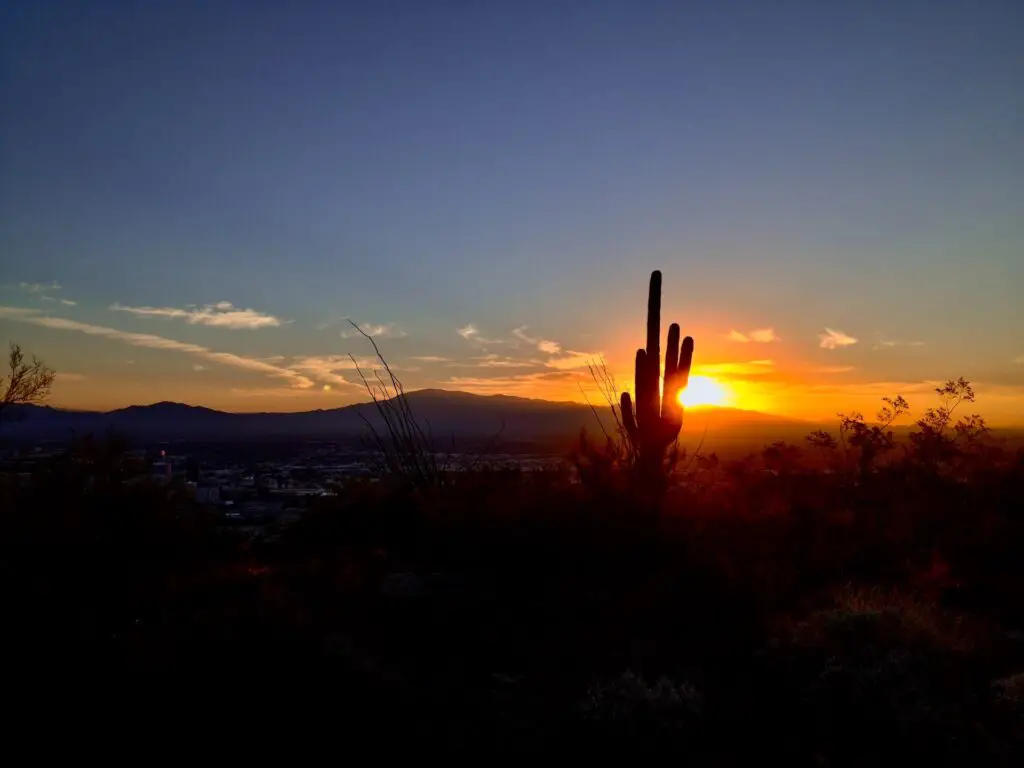
Catalina State Park is one of the best stargazing spots in Arizona, and you can easily add it to your itinerary thanks to its easy access.
You can attend one of the star parties held by different astronomy associations regularly here.
You can also camp here at the foothills and admire the stunning displays transforming the Sonoran Desert.
STONEMAN LAKE
Just over 100 miles north of Phoenix, Stoneman Lake is fabulous for catching the night sky views. If you are looking for some of the secluded places for stargazing in Arizona, Stoneman Lake is an excellent choice.
It is one of my favorite day trips from Flagstaff as the lake has so much to offer for all kinds of travelers.
Stoneman Lake is another shallow lake among the natural lakes in Arizona. It is one of the best lakes near Flagstaff if you want a ride to a secluded lake.
Stoneman Lake stretches about 46 miles south of Flagstaff, with magnificent views of Ponderosa pine covering, Gambel oak, and Arizona white oak-covered mountains.
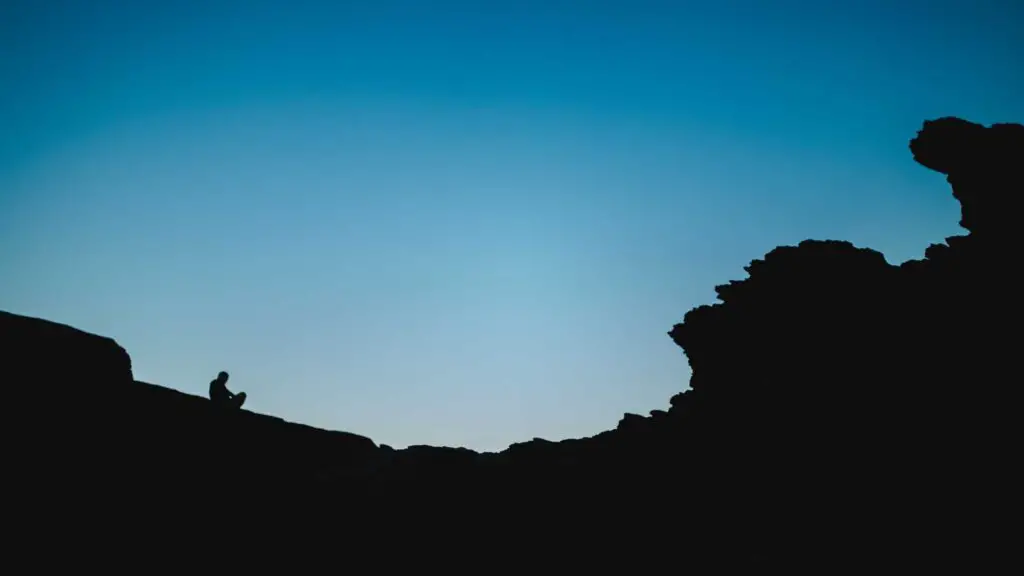
This medium-sized lake attracts many migrating birds when it is filled with water.
Bring your picnic blankets, bug spray, snacks and soak in the beautiful dark skies above the lake.
CAVE CREEK REGIONAL PARK
Located north of the city, Cave Creek National Park is one of the spectacular stargazing spots in Phoenix.
This massive 2,922-acre desert destination, one of the Maricopa County Parks, is known for its splendid winding multi-use trails, campgrounds, and picnic spots, which range in elevation from 2,000 to 3,060 feet.
You can drive around the park or choose one of the camping grounds, trails, or parking lots to take in the abundant views of the star-studded skies, making it one of the memorable nights in Arizona.
They even provide telescope on their stargazing events held regularly here. Bring your camp chair, blankets, and snacks for a fun night with your kids. Note that pets are not allowed.
SAGUARO NATIONAL PARK
One of the popular weekend trips from Phoenix for outdoor lovers and adventure seekers is Saguaro National Park.
Despite being close to urban areas including the lights of Tucson, Saguaro National Park is one of the dark skies in the state.
The clear skies above the horizon packed with magnificent cacti is definitely one of the best places for stargazing in Arizona.
Star parties are regularly held in the park making it one of the best getaways with your kids at night.
Saguaro National Park is home to huge forests of saguaro cacti, including America’s tallest and most iconic cactus species.
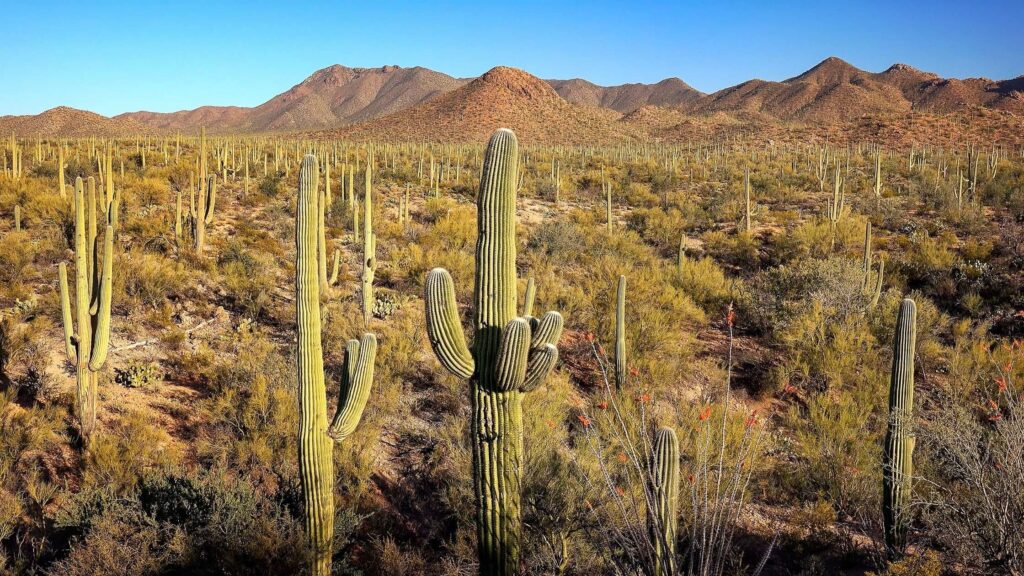
RECOMMENDED FOR YOU – 8 BEST CAVES IN SEDONA YOU SHOULD EXPLORE
Saguaro National Park is divided into two segments, one on either side of Tucson, named the Rincon Mountain District east of Tucson and the Tucson Mountain Unit west of Tucson, covering over 54000 acres.
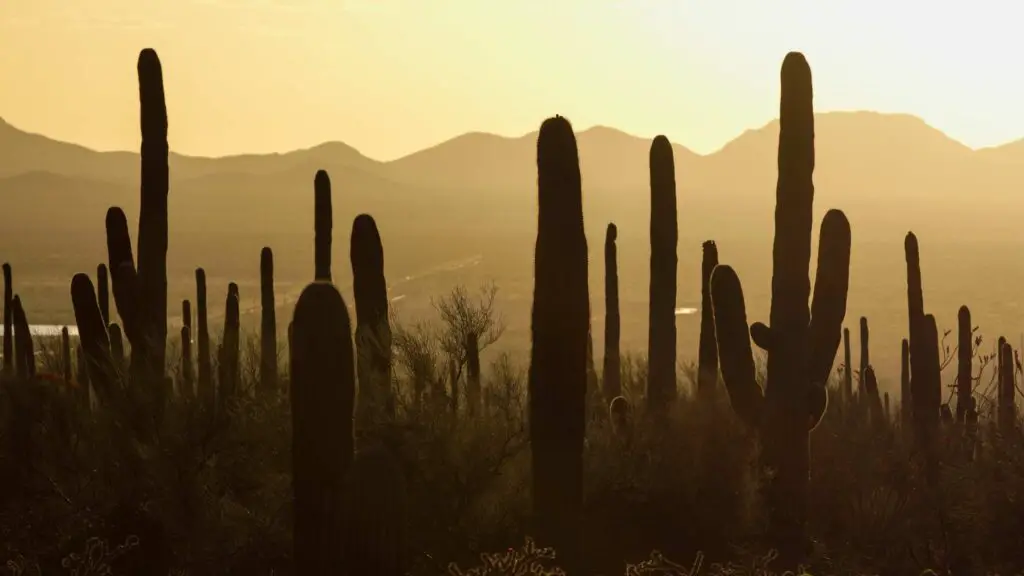
On the west side, in the Tucson Mountain District, which is smaller and more accessible, you’ll find the densest stands of saguaro and sweeping views from the Valley View Overlook Trail.
Although Saguaro National Park is a hiker’s paradise all year round, avoid the midday sun in the summer.
One of the most popular times to visit Saguaro National Park is late spring into early summer, the time of saguaro bloom with giant waxy white flowers, which is also an Arizona state symbol.
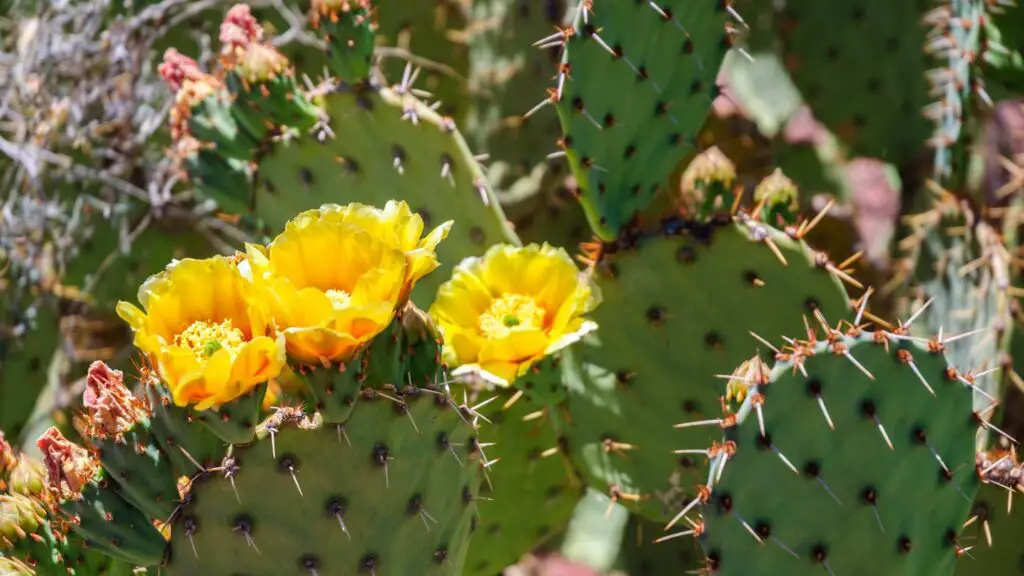
Other Saguaro National Park attractions include Native American rock art and a 19th-century homestead.
Check out the visitor centre for plant and animal exhibits.
The national park is home to roadrunners, coyotes, Gila monsters, and many types of snakes, which you should watch out for while hiking.
SUNSET CRATER VOLCANO NATIONAL MONUMENT
Just a short distance from Flagstaff in north-central Arizona is a fantastic world of volcanoes, lava tubes, and cinder cones.
One of the offbeat Arizona national monuments, Sunset Crater Volcano National Monument, is home to the Sunset Crater, the youngest of over 600 volcanoes that make up the San Francisco Peaks.
In this national monument rising above the foothills and lava fields surrounding it, you can view the dramatic jet-black lava flows and towering cinder cones of Sunset Crater, an extinct volcano with shades of red, orange and yellow that erupted about 1,000 years ago. It last erupted in 1085 that transformed the landscapes completely.
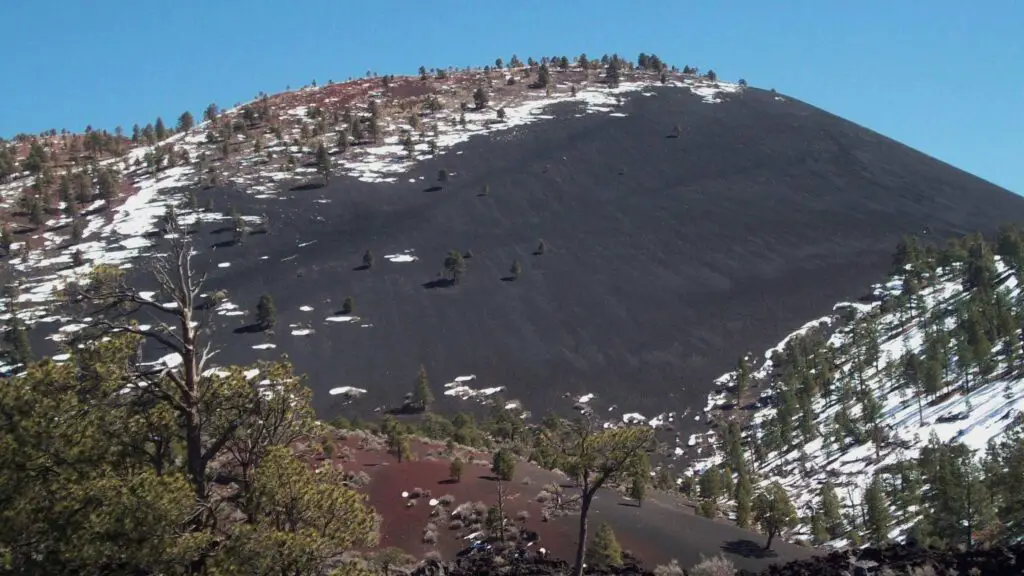
You can also camp, and check out roadside viewpoints.
One of the best places to enjoy the night sky in Arizona is Sunset Crater Volcano National Monument.
The easiest way to do this is to camp at the Bonito Campground.
The scenic drive trail is open 24 hours a day, all year, so if you are not into camping, it is a top place for driving around and stopping by to soak in the blissful Arizona night sky.
WUPATKI NATIONAL MONUMENT, FLAGSTAFF
One of the famous Arizona national monuments is located north of Flagstaff in the north-central part of the state.
Located next to Sunset Crater, Wupatki National Monument is a fascinating place encompassing a staggering series of archaeological sites and centuries-old settlements built by the Ancient Pueblo People.
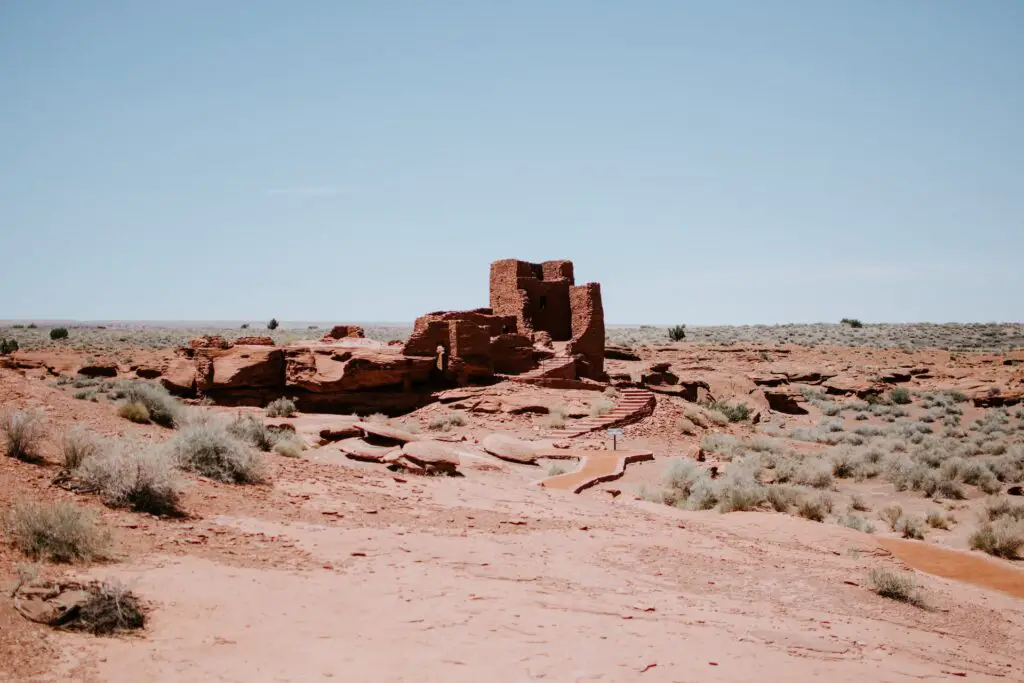
You can add a visit to Wupatki as one of the day trips from Flagstaff or combine it with a visit to the neighbouring Sun Crater, where camping is available.
The clear skies above the well-preserved monuments make it one of the best stargazing spots in Arizona.
Waupatki National Monument, known for being home to the ancient Anasazi or Pueblo people, comprises ruins of five red pueblo ruins dating to the 12th century, built from slabs of the region’s brick-red Moenkopi sandstone in the open grasslands symbolising the Sinagua and Anasazi cultures,
The pueblo is the ancestral remains of a Hopi Indian village, built by the Hisatsinom people, who are ancestors of today’s Hopi tribe.
The area was a farming community and was one of northern Arizona’s most densely populated areas since around 500 AD.
The violent eruption of the nearby Sunset Crater Volcano around AD 1085 forced people to relocate to a new area as ash was spread over 800 square miles of land.
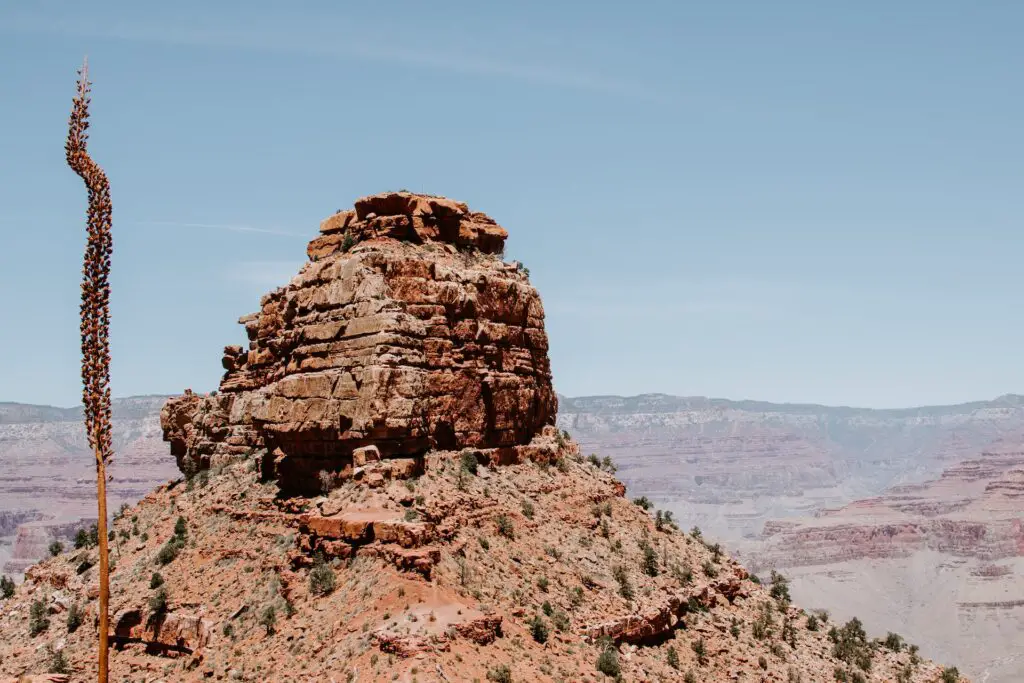
The sites were abandoned, with almost 2,700 buildings of bright red rock dwellings left behind.
Visitors can go inside the 900-year-old Wukoki Pueblo, the monument’s main attraction and the largest structure in the park.
This structure had over a hundred rooms and a ball court on show.
You can reach Wukoki Pueblo by a half-mile round-trip walk on a paved pathway.
Enjoy the gorgeous views over the Painted Desert and nearby San Francisco peaks from the trail.
Don’t miss the short hike up to Citadel Pueblo, atop a steep hill offering splendid views of the distinct desert’s wilderness.
RECOMMENDED GUIDED TOUR
From Sedona or Flagstaff: Ruins & Volcanoes Small-Group Tour
WALNUT CANYON NATIONAL MONUMENT
Another Dark Sky Park near Flagstaff is Walnut Canyon National Monument.
It is one of the famous Arizona National Monuments known for its historic ancient cliff dwellings and many fabulous hiking trails, offering plenty of outdoor activities for adventure seekers.
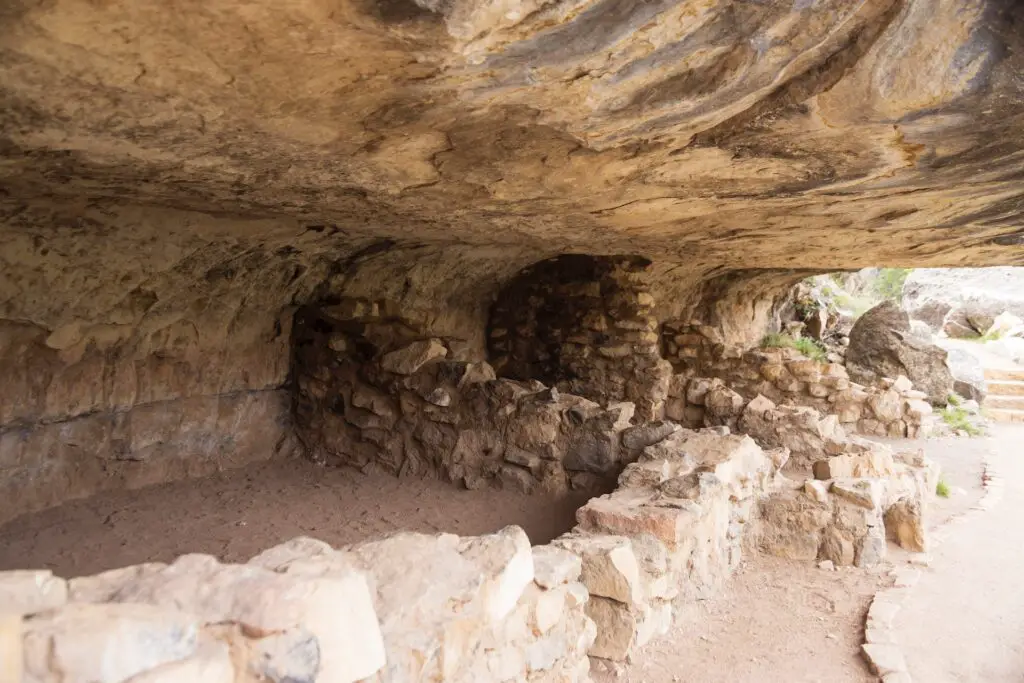
A 600-foot-deep gorge is home to more than 300 gorgeous Sinagua Indian cliff dwelling ruins from 1120 AD.
Walnut Canyon is known for its distinct and beautiful white Kaibab limestone formations, amidst which you will find many of these fantastic cliff dwellings, which were former family homes overhanging on the ledges of the canyons.
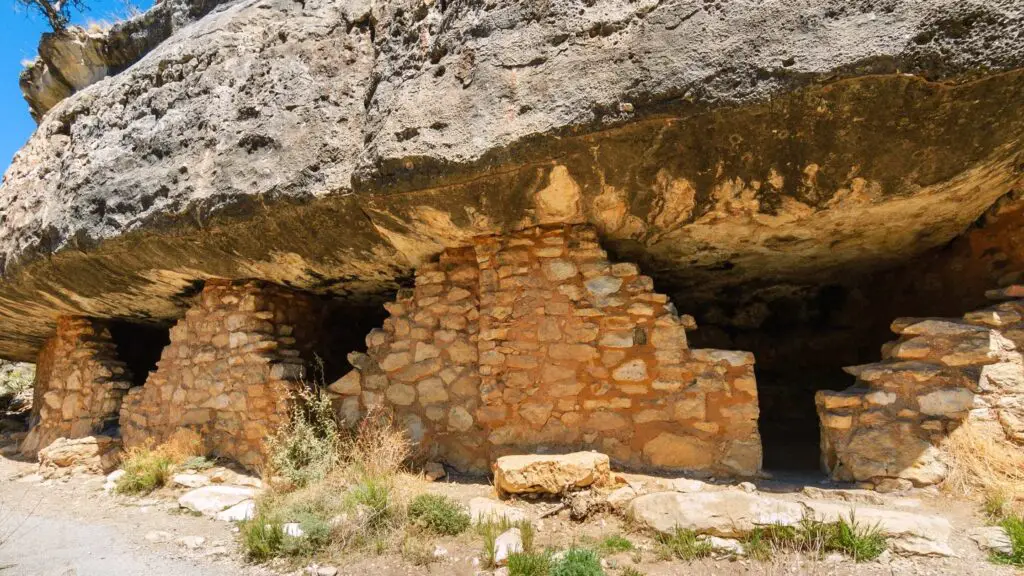
You will see the fantastic windows and doors of ancient dwellings tucked between uneven rock layers, examples of simple yet brilliant masonry skills.
Look down to see the beautiful Walnut Creek, the water source for the residents, flowing to the east to join the Colorado River, which eventually flows through the Grand Canyon.
There are no camping or lodging facilities within the park, but camping is available in the surrounding Kaibab and Coconino national forests.
The monument closes at night, but you can still drive in and stay until dark to watch the night sky from the rim.
KARTCHNER CAVERNS
One of the adventurous Arizona Bucket List things and among the best stargazing destinations in Arizona is Kartchner Caverns.
If you love exploring outdoors on your trip to Arizona in winter, just an hour east of Tucson lies Kartchner Caverns State Park.
The caverns, north of San Pedro River, are home to some of the world’s most fascinating and unique limestone formations, including stalactites and stalagmites spanning 2.4 miles of passages.
During the day, take a guided tour through these caves to explore the distinct landscapes, including various wildlife, such as bats, owls, and ringtails.
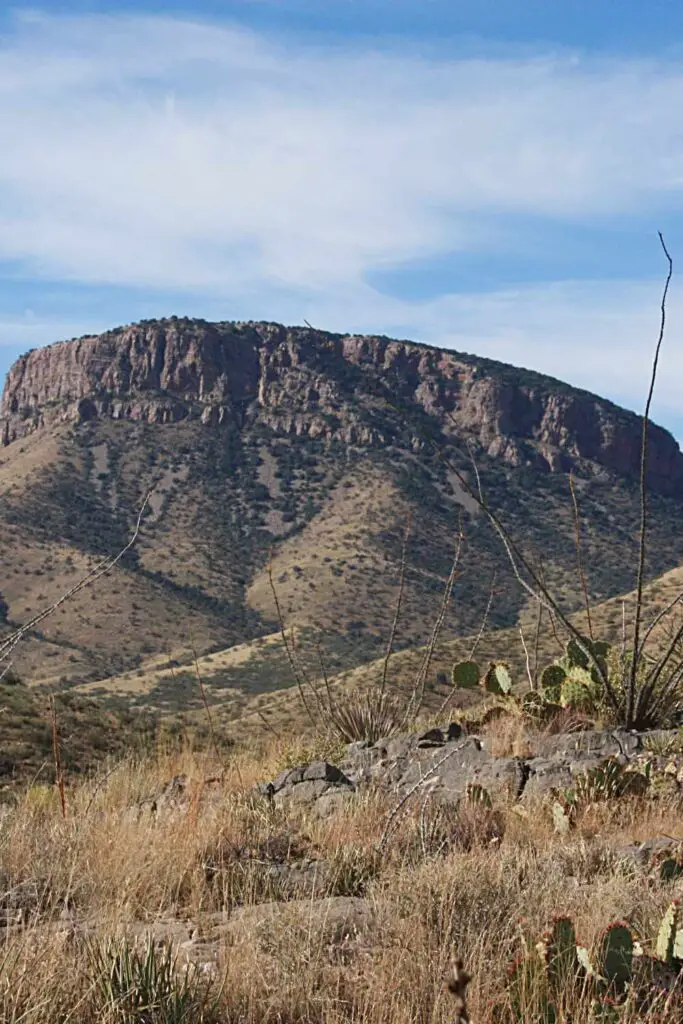
Thanks to its isolated location away from the cities, Kartchner Caverns State Park offers some of the darkest skies in the state.
You can choose to stay overnight at the campgrounds or cabins available at the park.
Enjoy the views of the stunning night sky wrapped in a cosy blanket. If you time it right, you can attend one of the star parties.
MCDOWELL MOUNTAIN REGIONAL PARK
One of my favourite stargazing spots in the desert is McDowell Mountain Regional Park.
If you want the rugged experience of watching the celestial dance surrounded by the spectacular desert, there is no better place than this park.
One of the top spots to watch epic Scottsdale sunset and sunrise is the massive McDowell Sonoran Preserve, spanning 30,580 acres of Sonoran Desert, featuring over 225 miles of trails to explore, loved by outdoor lovers, hiking enthusiasts and mountain bikers.
Open every day from sunrise to sunset.
You will be treated to gorgeous landscapes of the true Sonoran Desert wilderness packed with deep canyons, high mountain peaks, hundreds of varieties of cacti, and rich wildlife along its many trails.
If you are here during spring, the most popular season, you will also come across the magical, vibrant wildflowers standing out distinctly in the arid landscapes.
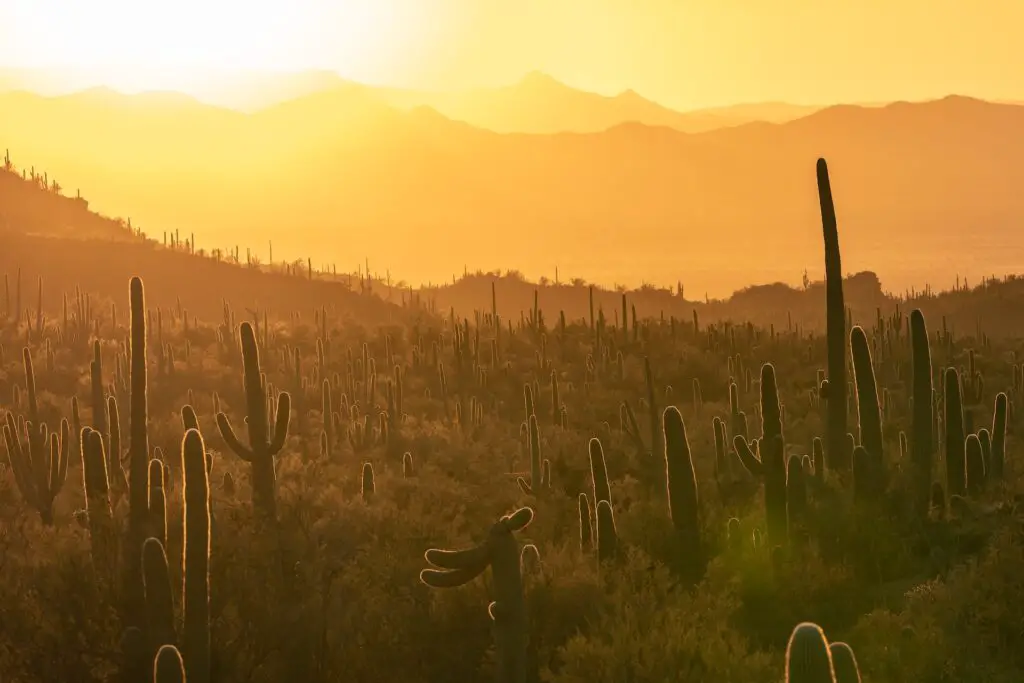
There are many trails to choose from, depending on your preference.
To make it easy, pick a route or viewpoint that faces east for one of the best sunrise hikes in the McDowell Sonoran Reserve.
You can choose from many picnic and camping spots to get off the road and take in the beautiful views of the night sky.
Stay on the trails, watch out for reptiles and cacti, carry a flashlight, and dress in layers since the landscape is pretty cold.
The park organizes regular guided moonlight walks and nighttime mountain biking treks.
ORACLE STATE PARK
One of the most famous parks in Arizona, Oracle State Park is one of the best Tuscon sunset spots if you are up for hiking amidst the desert landscapes overlooking the San Pedro Valley.
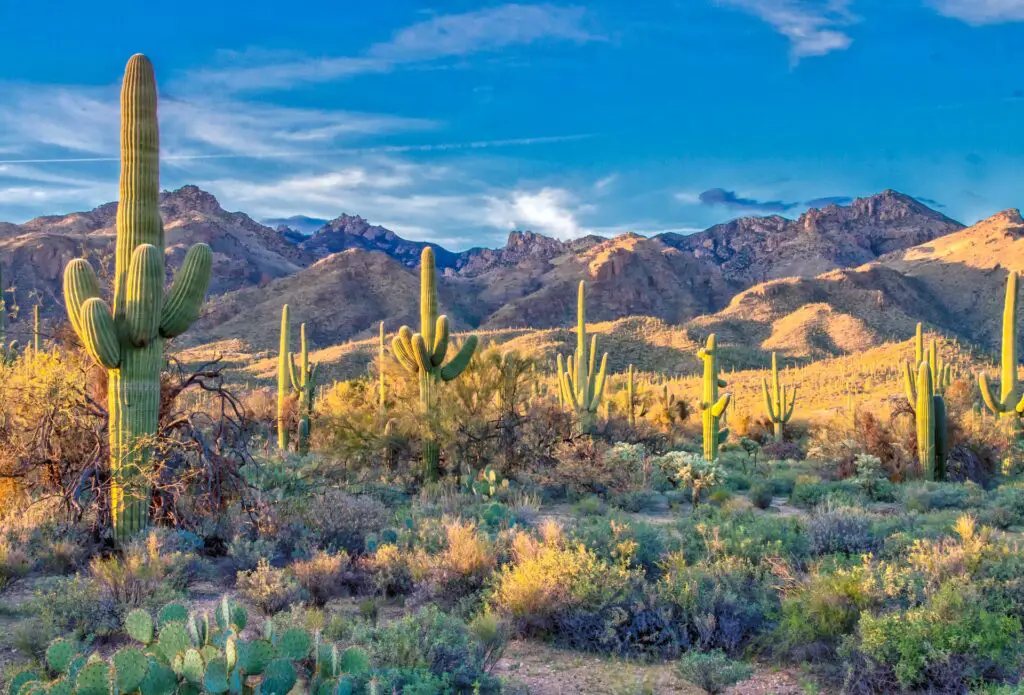
This high-desert park is known for many trails, but for watching stunning sunsets.
You will be rewarded with beautiful views of the Galiuro mountains to the east and the Santa Catalina Mountains further glowing in vibrant colours during the golden hours.
Oracle State Park is a designated International Dark Sky Park.
Thanks to its excellent location away from any lights, the views of the Milky Way are brilliant, and it is, hence, another exceptional place to watch the night skies in Arizona.
The Tucson Amateur Astronomy Association regularly hosts events here.
Though you can’t stay in the park overnight, the American Avenue parking area is available after dark.
DRIVE AROUND THE VERDE RIVER
If you’re up for a bit of a field trip, another road trip idea for stargazing in Phoenix is driving a couple of hours north of the city.
You will be led away from the bright city lights to the pitch-black desert, opening up a stark contrast to the beautiful display of celestial lights around the Verde River
Not only is the Verde River one of the desert’s few free-flowing rivers, but it is also home to an abundant riparian community.
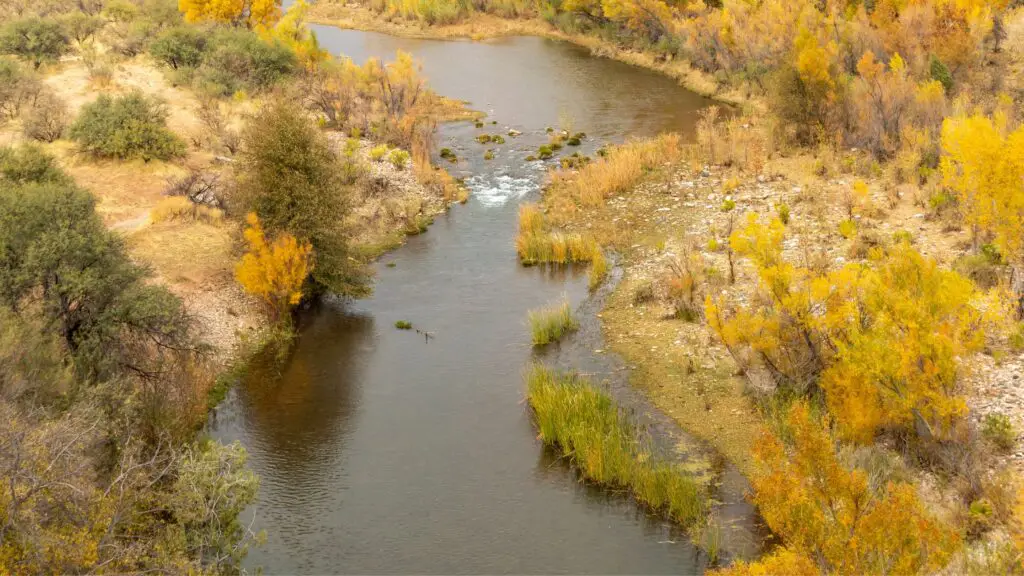
The best route is taking Pima Road north to Dynamite Boulevard(which becomes Rio Verde Drive). Continue for 13 miles, and then turn left on Needlerock Road.
You will then be parallel to the beautiful Verde River.
Stop along the way for snacks, views and rest as you are treated to epic panoramic views both around and above you!
LAKE PLEASANT
Among the most popular lakes near Phoenix is Lake Pleasant, located in the northwest, and it is no surprise.
Apart from being close to the central city, Lake Pleasant is a popular getaway among locals and tourists as they frequent it here for picnics and a weekend trip, thanks to loads of fun activities with something in store for everyone.
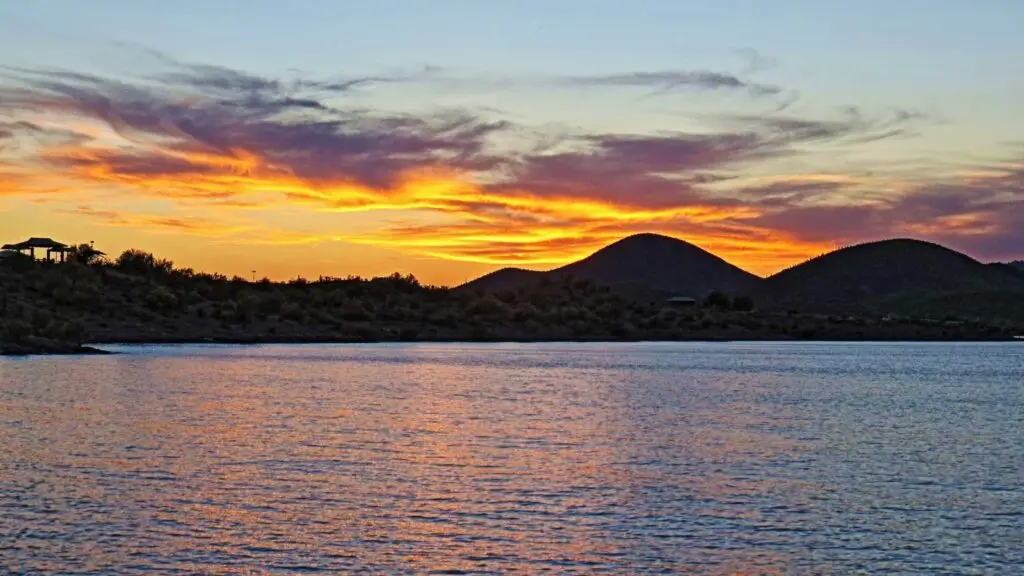
You can enjoy water skiing, boating, jet skiing, scuba diving, camping, fishing, shoreline hiking and more across its massive 116 miles of shoreline and 10,5000 acres area, with a depth of 70 feet and the deepest point going to over 170 feet.
Although it is an artificial reservoir, Lake Pleasant Regional Park is undoubtedly one of the most beautiful lakes in Arizona on a mountain, surrounded by stunning views of desert canyons all around.
This lake, open 365 days a year, has two marinas – Pleasant Harbor Marina on the southeast side and Scorpion Bay Marina on the west side, and two separate boat launching ramps, Scorpion Bay and Pleasant Harbor.
You can enjoy fishing channel catfish, bluegill, white crappie, and striped bass. The lake is also home to bobcats, herons, and bald eagles.
Lake Pleasant also has some pretty hiking trails with the popular one being the 3-mile out-and-back Yavapai Point Trail, rewarding you with incredible views of Lake Pleasant.
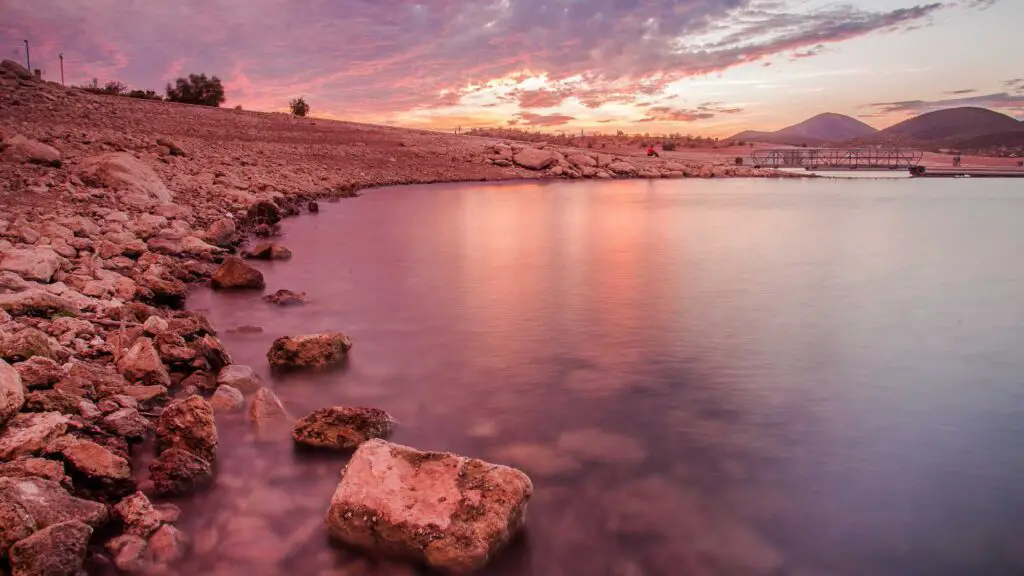
Especially if you are here in the spring, try adding this hike for splendid views of colourful wildflowers and beautiful views of the lake.
You can rent boats, paddle boards and kayaks at the marinas, but I highly recommend you reserve them online as the lake is pretty crowded during holidays and the weekends.
LOST DUTCHMAN STATE PARK
Among the top and easy-to-access places to watch the sunrise in Scottsdale is Lost Dutchman State Park, at the base of the beautiful Superstition Mountains near Apache Junction and Gold Canyon.
It is one of my favourite spots that I always stop by, if I am driving from Scottsdale to Tombstone, and a must item on Arizona Bucket List.
Lost Dutchman State Park in the Sonoran Desert got its name after the fabled lost gold mine.
Lost Dutchman State Park is one of the top spots for stargazing in Phoenix.
The stargazing experience here is as captivating as its legends, thanks to its excellent location away from city lights.
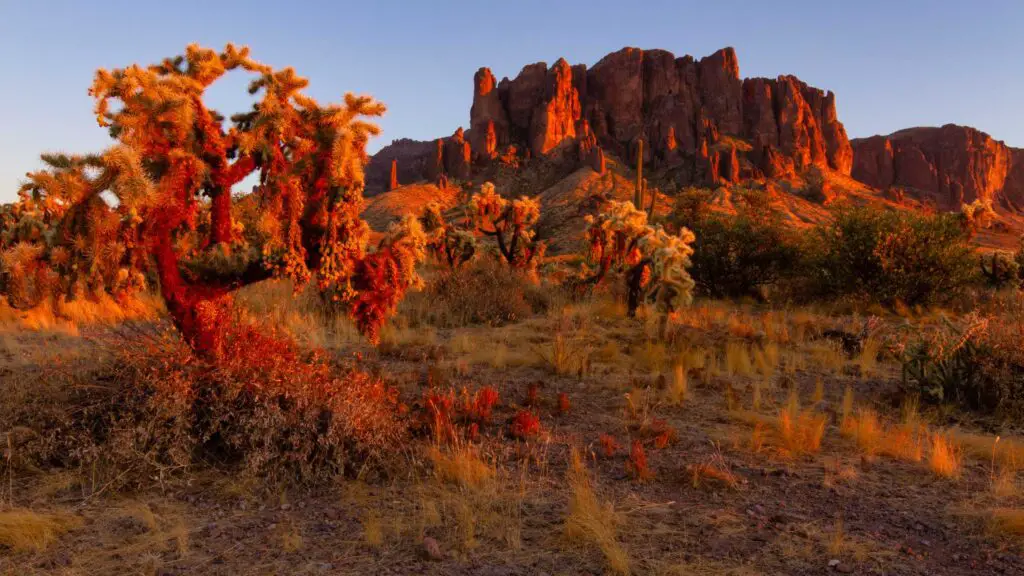
Lost Dutchman Park offers magnificent views of the Superstition Mountain ranges, making it a perfect spot to admire the star-studded skies.
An icon of the East Valley in the Phoenix Area, it is also a paradise for outdoor lovers. It is one of the top spots for Arizona winter hikes with your kids.
The parking lot is located at the entrance of Lost Dutchman State Park.
PICACHO PEAK STATE PARK
A quick trail and stunning views make it appear on Arizona Bucket List.
Among the best reserves to experience the wilderness of the Sonoran Desert is Picacho Peak State Park, which also offers some of the most incredible Tucson sunset views.
A short 40-minute drive from the Tucson area, you can plan an afternoon hike along the Sunset Vista trail, which takes you through the desert landscapes dotted with many cacti and wildflowers surrounded by rocky mountains.
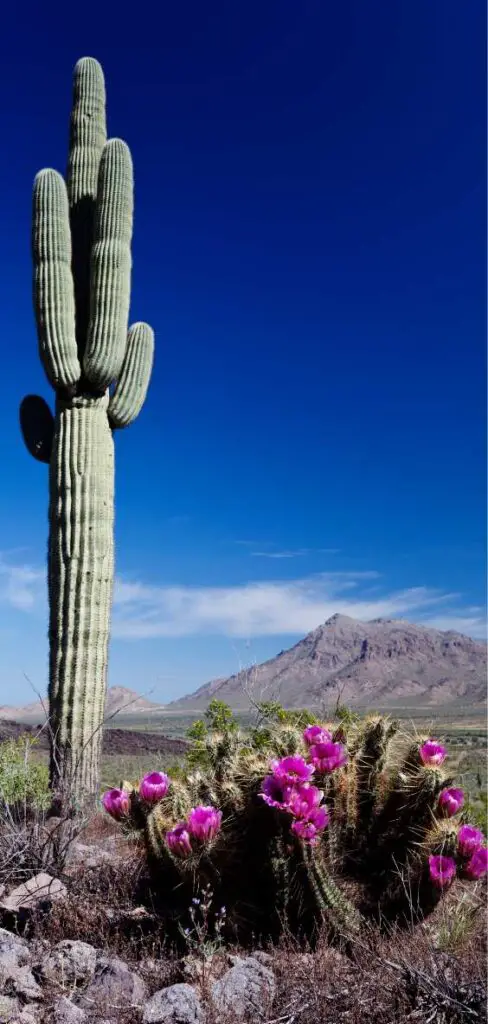
Picacho Peak is one of the best places to admire Arizona wildflowers.
If you are visiting Picacho Peak in February and March, you can see beautiful poppies sprinkled all over.
SOUTH MOUNTAIN PARK
Among the top attractions of Scottsdale, South Mountain Park is also one of the best places to watch an epic Scottsdale sunset.
You can spend a few hours or many days in this massive 16000 acres plus park offering tons of activities, from over 60 miles of hiking and biking trails to camping, rock climbing and much more.
South Mountain Park is the largest municipal park in the United States and one of the largest urban parks in North America.
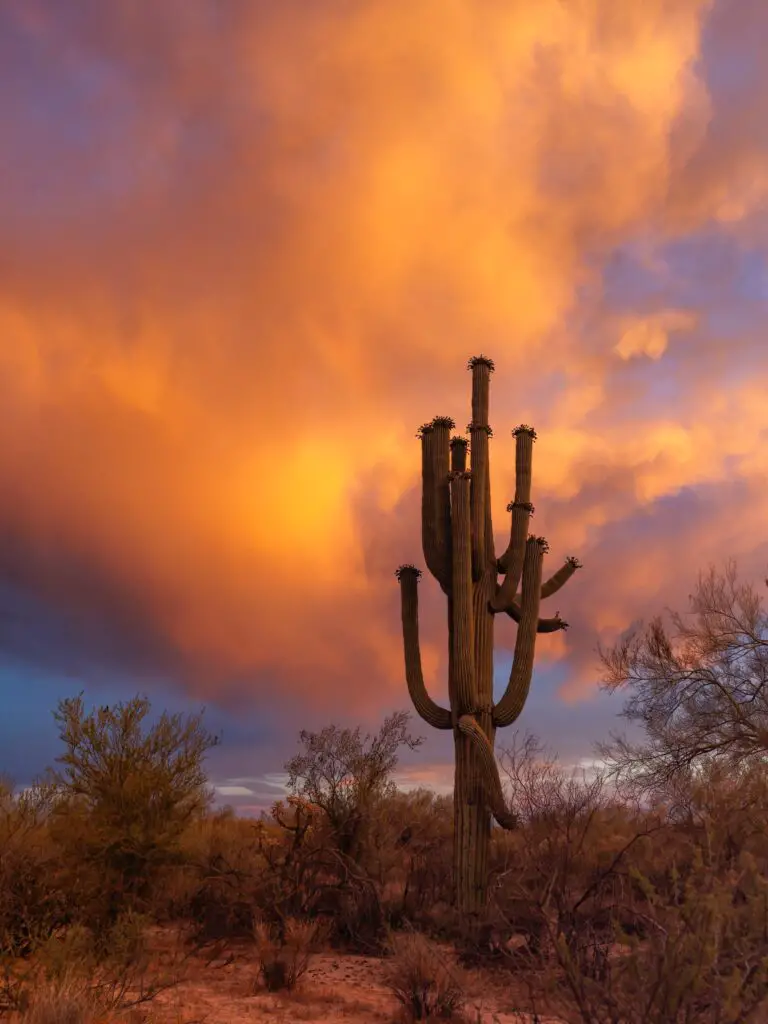
The best part is it is only about 30 minutes south of downtown Scottsdale, so the best spot to start your day is by going on one of the many sunset hikes in Scottsdale at Dobbins Lookout.
The trek to Dobbins Lookout is the most famous sunrise trail within South Mountain Park and Preserve.
At over 2300 feet, Dobbins Lookout is the highest accessible point within South Mountain Park and Preserve, the perfect spot for watching the skies painted with yellow, red, golden, and orange as the sun goes down over the downtown skyline, the Greater Phoenix area, surrounded by majestic mountains in the valley.
There are two ways to reach Dobbins Lookout.
You can hike the 4.6-mile round trip out and down Holbert Trail or take the easy route by car if you are not in the mood for a hike in the afternoon.
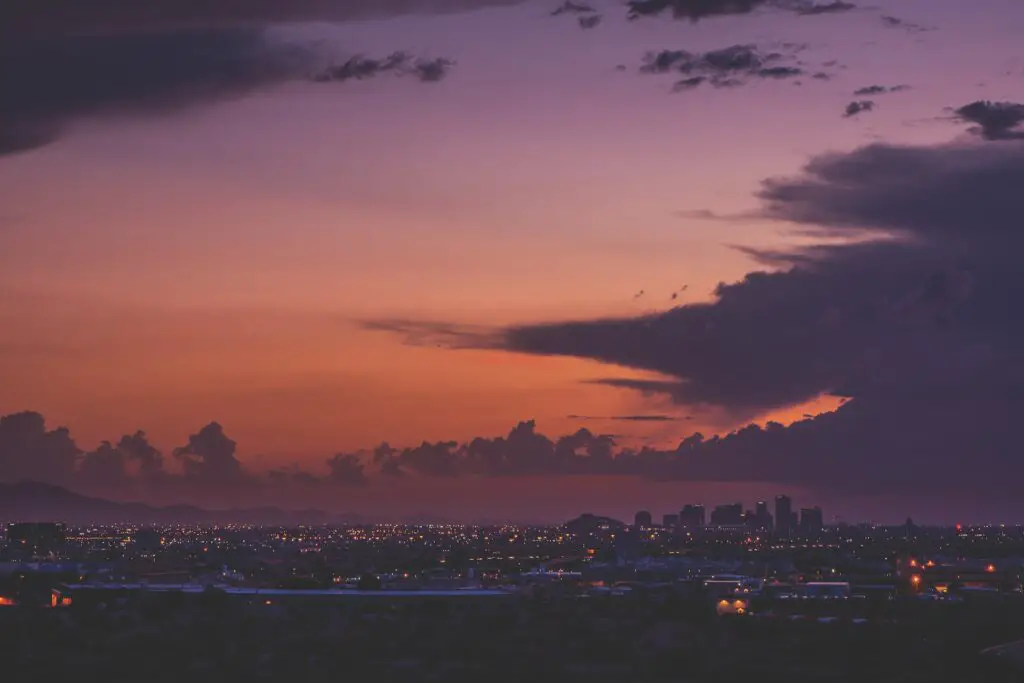
The views on the trail are far more rewarding, though, so it is the better choice if you are willing to sweat it a bit.
The trail has only short stretches of incline at the start and the end but almost flats out in the middle.
Throughout the trail, you will be treated to the rustic wilderness of the Sonoran Desert landscapes are dotted with beautiful wildflowers if you are here in spring.
ALAMO LAKE
One of my favourite lakes in Arizona is Alamo Lake, one of the secluded lakes surrounded by the beautiful mountains of western Arizona.
If you love fishing and want to get away from the crowds of the famous lakes in Arizona, try Alamo Lake. It is one of the best places for bass fishing in the state.
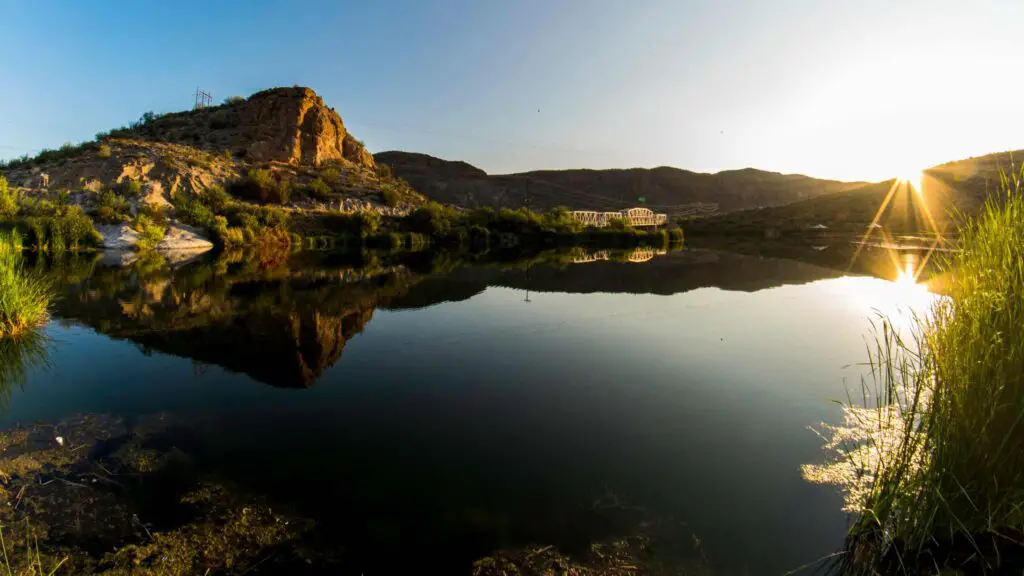
I prefer boating here as you have 3,500 acres of water to explore, and the best way to take in the stunning views and even enjoy some fishing is by renting one of the boats for a day.
You can swim, boat, ski, kayak, canoe or hike around the lake soaking in the blissful views.
Largemouth bass, crappie and rainbow trout are found in plenty for anglers.
APACHE LAKE
If you are looking for a quick day trip from the capital city, head to Apache Lake, about 2 hours away east.
One of the famous lakes near Phoenix, Apache Lake, is created by the Horse Mesa dam.
Apache Lake is one among the series of lakes located in the Tonto National Forest and is known for its stunning landscapes including the canyon walls at an elevation of 1,900 feet, spanning 2,568 acres and 40 feet deep.
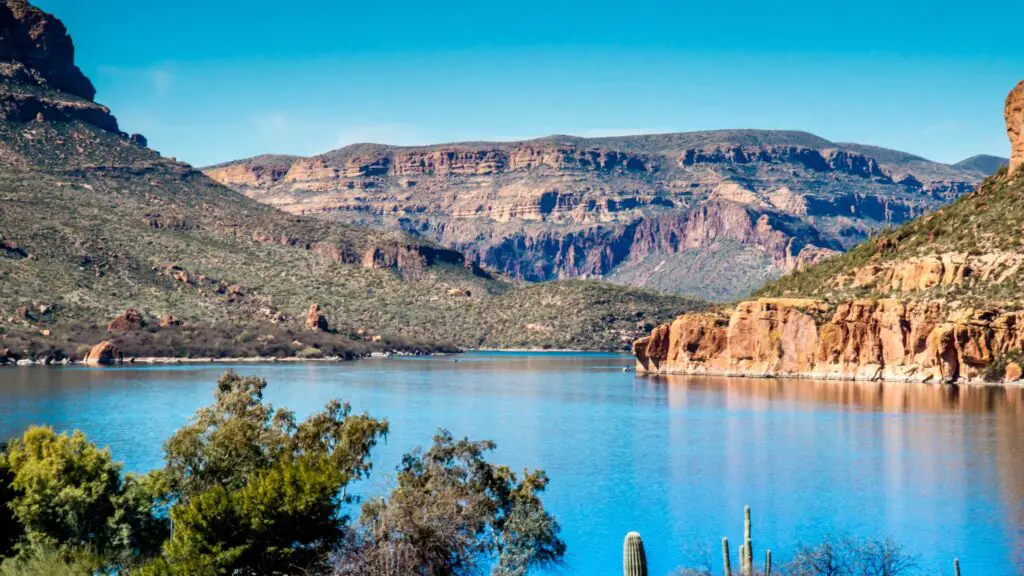
It is one of the largest lakes in the Salt River, providing a vast expanse for visitors for boating, canoeing, paddling, kayaking, SUP, and hiking trails leading to gorgeous overlooks.
You can also enjoy swimming, bass fishing, and water skiing.
Unlike the other lakes near Phoenix, getting to Apache Lake is a challenging drive best tackled with a high-clearance vehicle as most of the stretch is unpaved, making it a longer journey than it is supposed to be.
If you start early from Phoenix, it will be undoubtedly worth the drive as you will enjoy a day packed with lots of water sports and beautiful views.
Thanks to its excellent location away from the lights, it is one of the top spots for stargazing in Phoenix. If you are okay with the adventurous long drive, you can plan a day trip with stargazing
CATTAIL COVE STATE PARK
One of the top beaches in Arizona is located at Cattail Cove State Park, a stunning 2,000-acre park.
Situated on Lake Havasu’s eastern shore, about a 25-minutes drive, the park encompasses 61 campsites and boat ramps.
The main lake, 45 miles long, is a popular summer getaway thanks to the many fantastic hiking trails, grills, and picnic tables, apart from camping.
You can enjoy fishing largemouth, flathead catfish, crappie, bluegill, and striped bass.
The best time to go hiking is in March when the wildflowers bloom.
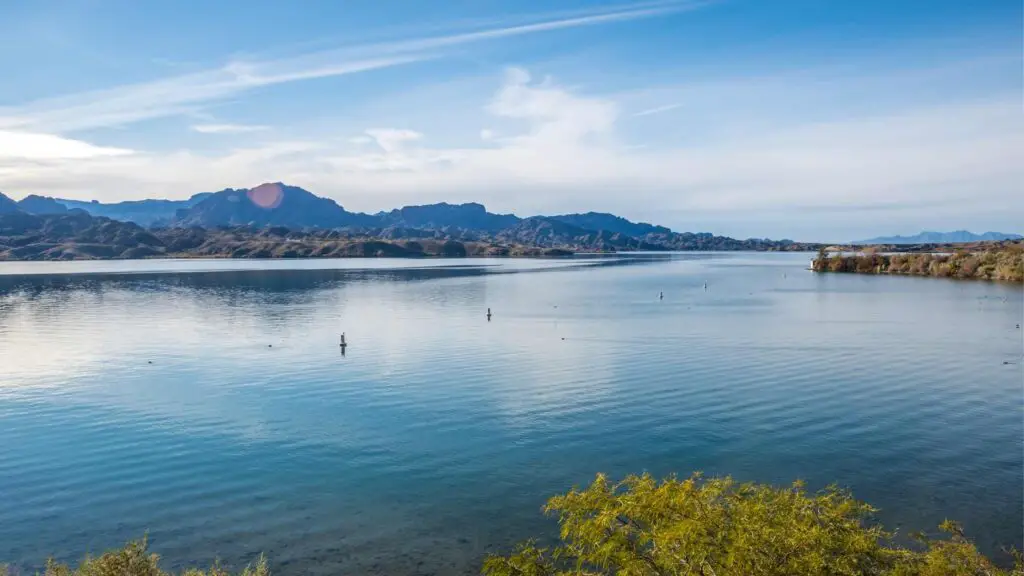
In the park’s day use area, there is a beautiful sandy beach where you can go kayaking, paddle boarding, or swimming.
There are well-maintained bathrooms and shower facilities at Cattail Cove.
While in Cattail Cove, check out the Bill Williams River National Wildlife Refuge, home to 355 species of birds and many reptiles, butterflies, and mammals.
Entry Fees – Day use ($10-15); Overnight parking ($15-20)
Recommended – 18 Best National Monuments In Arizona For Your Bucket list
Gradually, the sky starts opening up its treasure of millions of celestial bodies to you. You’ll notice differences in the brightness and colors of the stars.
Turn all your light sources off, and avoid looking at your phone, as the light on its screen will ruin your night vision.
I also recommend getting a red light flashlight to preserve your night vision. Also, avoid using your car headlights or any other lights that may disturb your experience.
Dress correctly
Most people underestimate how cold Arizona can get after sunset no matter the time of the year.It can get pretty chilly in the desert at night, so keep yourself warm.
It is best to dress in layers even in the summer. Bring a camp chair, a cozy blanket, and a star map.
Follow the Moon Cycle
I love full moons, and I always plan my stargazing trips when the moon is brighter and shining.
Some people prefer new moons, as they offer a darker sky, but if you are like me, I highly recommend trying stargazing in Phoenix on a Full Moon for a vivid experience.
Check the permits and keep the surroundings clean
If you are planning to stargaze in Arizona National Parks, you should check the permit requirements and stargazing times.
Also, beware of the desert critters like scorpions and rattlesnakes, keep quiet at night and leave the place trash-free.
For better photos
Even if you are a beginner or a casual photographer, I recommend bringing a tripod and remote shutter to capture the night sky. The difference in clarity and the overall quality of the pictures is massive.
